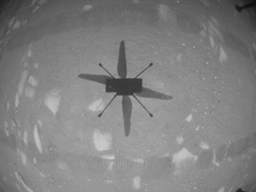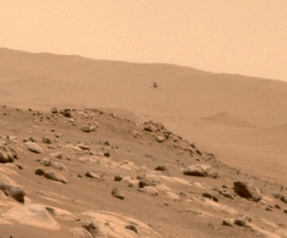
May 2021 - Vol. 25, No. 5
This Month's Night Sky - NOTE: The next paragraph describes the sky as it appears at 10 pm EST (11 pm EDT) near mid- month. The sky also looks this way at 11 pm EST (midnight EDT) during the beginning of the month and at 9 pm EST (10 pm EDT) by month's end.
As the days lengthen, the stars of the Winter Triangle fade into evening's dusk. The "Big Dipper" asterism (Ursa Major) is well placed for viewing this month since it is almost directly overhead. Follow the curve of its handle to Arcturus (Bootes) and continue on the curve to Spica (Virgo). Regulus (Leo) is on the ecliptic (the path traced by the planets and Moon), just W. of overhead. Further W., on the ecliptic, find the Gemini Twins, Castor and Pollux, and finally the Pleiades asterism of Taurus. So far this year, Mars and Aldebaran have been hanging out together, providing a nice double orange star display.
MERCURY emerges in the evening sky favoring southern observers, however, this is the best apparition for observers in the northern hemisphere this year. VENUS in evening twilight sky, continues to separate from the Sun. MARS in the evening sky visits the constellation of Gemini this month, it will start out at 1.6 mag dimming to 1.7 by month's end. JUPITER rises in the morning sky about half an hour after SATURN. SATURN rises about 2 am at the beginning of the month, and around midnight at the end of the month, as Earth begins to overtake the slower outer planets. URANUS emerges in the morning sky by month's end. NEPTUNE rises in the morning, as well amoung the stars of Aquarius.
Review how to determine Angular Measurement.
Calendar of Events
NOTE: For those observers not in the ET zone, convert the calendar times to your zone's time by subtracting one hour for CT, two for MT and three for PT. Don't forget to adjust for Daylight Savings Time when necessary by subtracting one hour from your planisphere's time. Dawn and dusk times must also be corrected. See your local newspaper, TV news, or cable TV's Weather Channel for sunrise and sunset times or check with the U.S. Naval observatory. Unfortunately some of these events may occur during daylight hours in your area.
| DATE | EVENT |
| 03 | Saturn 4 deg. N. of Moon. Mercury 2 deg. S. of the Pleiades. |
| 04 | Jupiter 5 deg. N. of Moon. |
| 06 | Mercury at greatest heliocentric lat. N. Eta aquarid meteor peak. The shower produces up to 60 meteors at its peak. Dust particles for this meteor shower are generated by Halley's comet as it approaches the Sun on its 76-year orbit. This year's young moon should not be a problem, shower's peak is at 2 UT. |
| 11 | Moon at apogee. |
| 12 | Venus 0.7 deg. N, of Moon, occultation from New Zealand, E. Polynesia, and Easter Island. |
| 13 | Mercury 2 deg. N. of Moon. |
| 16 | Mars 1.5 deg S. of Moon. |
| 17 | Mercury at greatest elongation E. (22 deg.) |
| 23 | Saturn stationary. |
| 26 |
Moon at perigee, expect large tides. Total Lunar Eclipse! Totality is visible in Australia, parts of the western US and South America, and SE Asia. Totality last for only 14 minutes, but this full moon is called a Super Full Moon because it the Moon also at perigee this night. Most locations in North America will see some of the eclipse. |
| 29 | Mercury 0.4 deg. S. of Venus. |
| 30 | Mercury stationary. |
| 31 | Saturn 4 deg. N. of Moon |
Lunar Almanac for May 2021
| Phases of the Moon | Phase and Date(s) | Best viewed before local midnight |
 |
New 11 |
Deep Space Objects |
 |
1st. Qtr 19 |
Planets & Moon |
 |
Full 26 |
Moon |
 |
Last Qtr 03 |
Deep Space & Planets |
Topic of the month: Ingenuity Helicopter

NASA launched its Mars 2020 mission In July, arriving safely at Mars in February 2021, and its mission has begun. Mars Perseverance was NASA's 5th rover to land successfully on Mars. The Mars 2020 rover, Perseverance, also called Persy, carried a small helicopter in its belly. This helicopter is named, Ingenuity and has proved for the first time that flight is possible on another planet in the solar system, specifically, Mars! The helicopter carries with it a piece of the original Wright Brothers Flyer.
The first flight came on April 19, 2021. The helicopter rose 10 feet or 3 meters into the martian sky. After hovering, it rotated and landed successfully. The whole flight sequence took only 39 seconds, but Ingenuity proved itself expertly. Ingenuity took a picture of its own shadow while it was performing its first flight. It was very exciting to see this image of Earth's first interplanetary flyer.
Ingenuity was not intended to assist the Perseverance rover with its primary mission, instead it was added as a technology demonstration. Its purpose is to test powered flight in Mars' thin atmosphere, operate autonomously, and test miniaturized flying technology (i.e., computers and electronics). In April 2021, Ingenuity proved itself by making 4 powered flights.

Ingenuity's second flight occurred on April 22 , 2021. It rose up 16 feet (4.9m)in a vertical takeoff. It had to hover briefly, then move toward the West. It moved, rotated clockwise, and then returned to the spot where it originated and landed. For this flight it had to stop its movement above the ground. The helicopter flew .5 meters per second during this flight. It lasted 51.9 seconds, less than a minute! It doesn't matter that the flight was short, it still proved that the atmosphere on Mars could be used to lift and navigate the small helicopter. During the flight Ingenuity took the first color image of the Martian surface taken by an aerial vehicle while it was aloft.
Ingenuity's second flight was followed up on April 25, 2021 with an 80-second flight. For this excursion, the helicopter took off vertically, moved toward the North, once again turned around and landed where it started its flight. This time the helicopter rose 17 feet (just over 5 meters) and flew at .2 meters per second, a bit faster than on its second flight. Ingenuity's launch and landing site has been named, Wright Brother's Field by the Mars Helicopter Team.
There was an unsuccessful fourth attempt on April 29 and a re-flight on April 30. During this 4th flight, the helicopter rose 16 feet (5 meters), flew toward the South approximately 436 feet (133 meters) and then back, for an 872-foot (266-meter) round trip. Ingenuity was in the air for 117 seconds. During this flight the helicopter took many more images than it had on previous flights.
NASA Mars2020 Mission

Perseverance Rover can't stand to be left out of the picture. Here is a close up selfie that Persy took with Ingenuity on April 6, 2021. NASA released this image and all of the others that are here in this article. Some of them have been modified (i.e. cropped and shrunk) to fit the web pages here at Astra's. There are many images available from NASA with more appearing regularly. NASA's original image of Perseverance’s selfie with Ingenuity is made up of 62 individual images stitched together once they are sent back to Earth. This image is taken with Perseverance's WATSON (Wide Angle Topographic Sensor for Operations and eNgineering) camera at the end of the rover's robotic arm.
Ingenuity will continue to prove itself on planet Mars, it is scheduled for its fifth flight in early May. The fifth flight would send Ingenuity on a one-way mission, landing at a new site instead of returning to its original location. If Ingenuity is healthy after those flights, the operations demonstration phase will begin. NASA decided to add an operations demonstration phase to Ingenuity's mission due to its own successes and the rover team's decision to explore some rock formations nearby. Along with one-way flights, there will be more precision maneuvering, greater use of aerial-observation capabilities, and more risk of course.
Finally, I've embedded a movie from NASA showing Ingenuity in flight. If you don't see the helicopter in flight or you want watch it again, click on the movie to start it.
For more information on the spacecraft that arrived at Mars in February 2021, check out Astra's Mars 2020 page.
Don't forget to check at NASA for the latest details and images on Ingenuity and Perseverance rover!
--See You Under the Stars!
Astra for Astra's Almanac
This installment of "What's Up?" is ©2021 by Dawn Jenkins for Astra's Stargate. View Ron Leeseburg's Farewell Issue for information on where to find information such as is presented in this almanac.